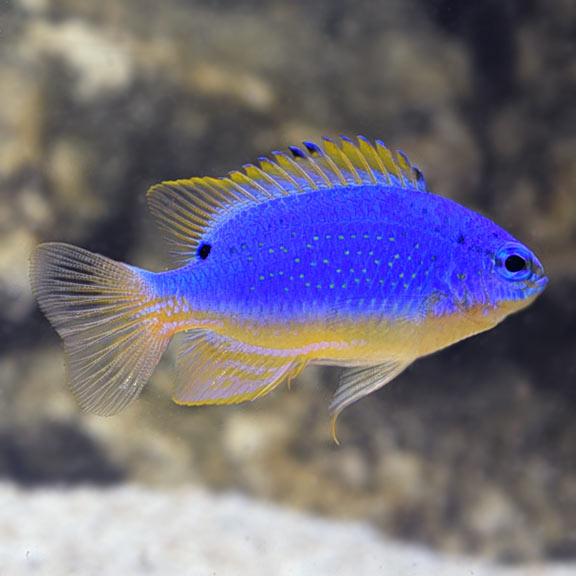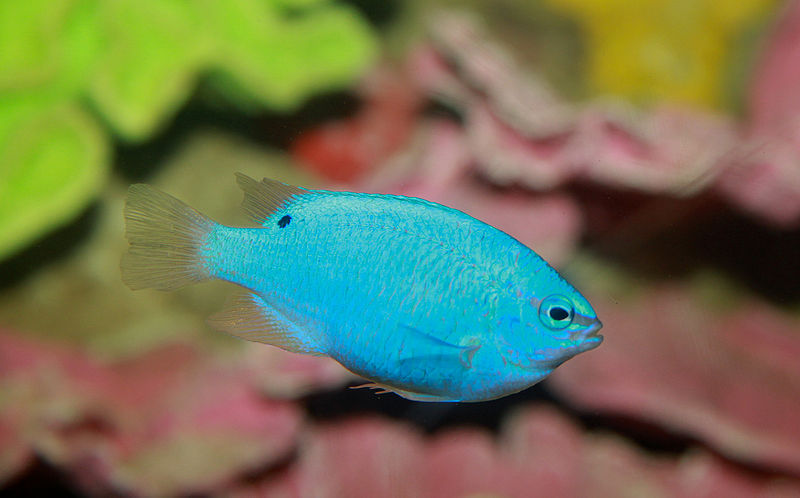If you’re looking for a feisty, fun fish that’s bold and brash, the blue devil damselfish is a great place to start. This saltwater staple is likely to brighten up any aquarium. However, keep in mind that it does have a few particular needs, and it can be a bit aggressive with more timid species.

Keep reading and we will fill you in on everything you need to know about the blue devil damselfish!
- Fish Lifespan: Between 2 and 6 Years
- Tank Size: Ideally more than 55 gallons – at least 30 gallons for a single fish
- Water Temperature: Between 72 and 78F
- pH: Between 8.1 and 8.4
- Hardness: Between 8 and 10 dKH
- Compatibility: Compatible with Basslets, Chromis and Blennies
- Fish Size: Up to 3 inches
How do you take care of blue devil damselfish?
Blue devil damselfish will need a fairly large tank, with at least 30 gallons ideal if you have at least one. However, you’ll need to double this if you have a handful of them. They tend to do well with fish bigger than itself in temperatures of up to 78F.
You should try and give these fish a mix of food. They, like most damsels, are omnivores, which means they will need a good balance of herbivore mix as well as meat. They also like munching on flakes. However, given their famous temperament, these fish can often fight to get to the best food – so be alert!
Are blue damselfish aggressive?
Blue devil damselfish are known to be particularly aggressive. They don’t mix well with smaller species in the same tank and can be known to bully more timid species. Therefore, they should either be kept on their own, or you should look to mix them with species such as basslets and blennies.
It’s also not a good idea to try and mix these damselfish with other types of damsel, either. The aggressive nature of this fish doesn’t make it a horrible pet! It just means you have to be extra careful with the tank mates you introduce into the community.
They tend to get territorial fairly easy. It’s a good idea to try and have a few nooks and spots available where they can zip in and out and hide. Despite being really tiny, blue damselfish have attitudes that make them larger than life. Therefore, it’s a really good idea to protect your more timid fish.
How big do damselfish get?
Damselfish in various species can grow to be four to five inches in length, but the blue devil damselfish tends to be a smaller variety, only ever really growing to be three inches in size.
.jpg)
This, however, doesn’t mean you should ever pop them in a smaller tank. It’s probably tempting to go for smaller spaces for smaller fish, but the blue devil damselfish has a big personality, and is going to need to move around a lot.
As mentioned above, you should ideally look for tanks at least 30 gallons in volume. If you want to adopt several blue damsels, go as big as you can. They love to explore, and while they are tiny, they won’t get lost. The bigger the tank, the happier blue damsels will be, on the whole!
Why is my damsel fish turning black?
Don’t panic! It’s camouflaging itself.
The blue devil damselfish has the amazing ability to turn dark, or black, at will. It does this when it finds itself a little space or hole to swim into and hide.
A blue damselfish will normally only hide itself for a few moments, meaning its new black shade shouldn’t last for too long. Once it no longer feels under threat, you’ll normally see your fish return to that brilliant blue shade like before.
If you are worrying about the colour changing tendencies of the blue devil damselfish, you should always consult your vet or local aquarium expert. However, it’s perfectly normal for a blue damselfish to want to take cover and hide occasionally, even though they have this reputation to get pretty feisty!
Do damselfish have teeth?
Yes – damselfish have minute teeth which they use to help eat algae, as part of the herbivore portion of their diet.
This, some fish keepers feel, can help add to their feisty nature and attitude! However, many other fish have teeth – but damsels tend to have sharp little nippers that they generally use for grinding greens, not for flashy toothy grins.
In fact, you might even already be able to tell if your damsel is a particularly toothy customer. If you listen closely, you can sometimes heat damselfish clack their teeth together! Of course, you’re going to need a particularly quiet tank to test this out, but trust us – on a quiet day, you’ll be able to hear their gnashers chomping!
As damsels are omnivores, it makes sense that they would have teeth to be able to cut into meat as well as vegetation. We certainly wouldn’t want to get on the wrong side of their chompers, however!
What is the least aggressive damselfish?
Blue devil damselfish are certainly not the least aggressive. That honour tends to belong to species that belong to the Chrysiperta family of damsels.
Some Chrysiperta damsels include the azure damsel, the springer’s damsel, the yellowtail damsel and the starck’s damsel. These tend to be fairly tame damsels on the whole, which to some fish keepers might sound like a bit of a revelation!

After all, all damsels seem to have this reputation for being feisty, bold little critters. If you’ve ever owned any, then you’ll likely know that this is a pretty good description for them. Even the smallest of damsels have big characters and will likely defend themselves to the end.
However, that doesn’t mean even some of the more aggressive damsels, such as the blue devils, aren’t known for their placid moments. As described above, blue devil damsels tend to want to hide occasionally when they feel under threat, and will go as far as camouflaging themselves in the dark!
Less aggressive damselfish are ideal if you want to set up a fairly peaceful tank – though you can also sometimes foster peace if you place blue devil damsels in alongside bigger fish with similar aggression levels. It’s just a case of being careful putting damsels anywhere near shy or timid fish, as they may get bullied out of getting any food, as well as saving themselves any space.
How can you tell if a damselfish is male or female?
Blue damselfish are fairly easy to tell male or female providing you look carefully at their fins and tails. Of course, it’s not easy to tell these difference until they start maturing into adulthood.
For example, female blue devil damselfish will normally have spots at their dorsal bases if you look carefully enough. Male damsels in this species will develop orange tails over time.

Not all damsels are easy to spot on the whole, meaning that keen fish keepers will likely be happy to learn that it’s relatively simple to narrow down the genders of blue devils.
This can make them fairly easy to breed if you know what you’re doing. Generally, males will normally make clicking noises to attract mates, and will normally swim around wildly in an effort to make a good impression. If you’re lucky enough, you might be able to spot this in action!
Should I Adopt a Blue Devil Damselfish?
Yes – providing you have read through their various needs and requirements. Despite the fact that blue damsels are known for being pretty aggressive, they are really fun to keep as pets in your saltwater tank. Their sprightly personalities may turn sour if you give them free reign over smaller fish they can bully out of the way, but providing you know what you’re getting into, there are no reasons why you shouldn’t consider blue damselfish.
Just make sure you have a big enough tank for these fish, and always ensure you know which fish – in terms of temperament and size – you can mix them with. While it may seem reasonable to house them with other types of damsel, this doesn’t always go well. We’d advise against it unless you are experienced with saltwater fish and really know what you’re doing.
Blue devils can be great beginner saltwater fish thanks to the fact that they are so hardy and can be left to their own devices. They only start becoming a handful when other fish enter the equation. Don’t worry – they’re unlikely to be aggressive towards you – just other species that dare intrude on their personal space in the tank!
Make sure to prepare a warm tank with lots of hiding places for these fish. They are also reef-friendly, which means you can add even more colour to your saltwater aquarium with a few coral stacks and plants.
All in all, blue damsels are rewarding pets – but be careful with that attitude every once in a while!



